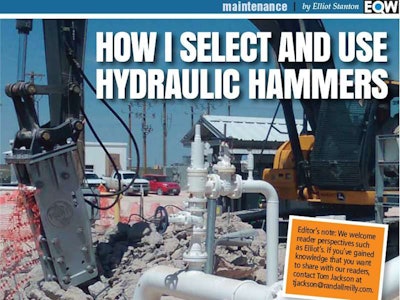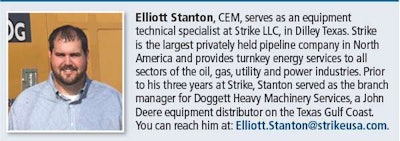
It’s not hard to understand why: a hydraulic hammer can cost up to 20- to 40-percent more than the carrier it’s mounted on, and can require two to three times the maintenance and repairs over the course of its life. Additionally, contractors often have more questions about hammers than they do reliable answers.
Ask around
Over the past 12 months, part of my job as an equipment technical specialist at Strike LLC in Dilley, Texas, was to research options in the hydraulic breaker market for my employer. During my search I learned a lot about hammers, and hopefully this information will remove some of the mystery surrounding hydraulic breakers.
When I first started this project, I talked to several contractor friends to get their input on hammers. I found that most had purchased whatever their dealer offered, mainly due to the lack of reliable information. They all had a brand or two they liked, a few shared a brand they’d never own again, but most agreed their knowledge was limited and that they didn’t really know how their hammer stacked up against other products. I also turned to our own fleet data and looked at the repair costs vs. hours of use on the hammers we already owned.
If you Google ’hydraulic hammers’, you will find a myriad of companies and offerings. There are plenty of online forums with posts about the good, bad, and ugly of different brands. One contractor’s favorite was another one’s worst nightmare. It was easy to see why so many people just buy what their local dealer offers and hope for the best.
However, I also identified a couple of brands that merited additional research, added the best of our current manufacturers, and then finished off the list with a few recommendations from other contractors and sales reps. I took that list, put out requests to vendors and compiled as much information as I could find online. I looked at the purchase costs, warranties, support availability and any references they had.
Do a demo
At the end of our search, we conducted a demo on a jobsite with the finalists. Equipment is a major investment; demos help ensure you’re maximizing the return on those dollars. Most manufacturers or dealers will be happy to let you run a machine for a day or two to ensure it performs to their claims and your expectations. With hammers and other attachments, I recommend performing a demo with the carrier you plan on using it with most often. Seeing it run on your tractor is the only way to ensure you get the performance you’re expecting.
The main criteria I used for my comparisons fall into a few separate categories.
Size matters
Not all 5,000 pound hammers are the same. But, since there aren’t established industry standards for hammer sizing, it’s pretty much left up to each manufacturer to size their products. One company’s 5,000-pound hammer could be the same size as another company’s 7,000-pound hammer. So, how do you compare apples to apples?
The best method I’ve found is by using the piston diameter or bit diameter. All things being equal, the piston size is going to determine how hard a hammer hits. A 5,000-pound hammer with a 4-inch diameter bit is unlikely to out-produce a 5,000-pound hammer with a 5.5-inch diameter bit. I also take into consideration the weight of the hammer, but the piston or bit diameter is the best indicator.
It’s critical to ensure that the hammer you select is the right size for your carrier. A hammer that is too small can be damaged by the weight of the carrier or excessive hydraulic flow. Having a hammer that is too big will result in weak or slow strikes, reducing productivity.
Go with the flow
The next step is to check the flow requirements for each hammer and make sure it matches your carrier. Some hammers require more flow than others to operate correctly. Without sufficient flow, you’ll end up with a slow, unproductive hammer and a lot of overtime. Too much flow for a hammer will cause overheating in the hammer and the carrier, destroying seal kits in both and potentially ruining the hammer.
Keep in mind that even correctly sized carriers can overflow a hammer. Today’s construction market has a multitude of attachments, some requiring large amounts of flow or high pressure to operate. Carrier manufacturers have responded with new models that have hydraulic systems capable of running these attachments, meaning the potential to overflow a hammer is significant. Before you put any attachment on a carrier, have the unit flow tested to make sure you have it set within the safe zone for that attachment. This is critical. Perfectly good hammers have been destroyed in a few short months by running them on carriers not properly flow tested for that unit. The cost of having a dealer or mechanic set the flow is a fraction of the cost of rebuilding or replacing a hammer.
See the future
Everyone looks at the purchase price of a new piece of equipment. However, with hammers, I also recommend that you find out the cost of resealing and rebuilding them. One of the frequently overlooked aspects that surfaced while researching our current fleet was that some of the more competitively priced hammers actually had higher repair costs when it came to parts and labor.
Most hammers will have to be resealed periodically. Knowing the cost of the seal kit and the amount of labor required can prevent huge repair bills in the future. Also, take a few minutes to ask the service manager how often they expect to reseal the hammer. I didn’t give much weight to that information, as it’s subjective and highly variable, but I did learn a lot about different hammers by asking that question.
Ask for references
Most people will hesitate to ask for references, but it’s a valuable tool that can help you make a good buying decision on new products or vendors. Most dealerships have large enough footprints and customer bases that they can provide you with a non-competitive contractor/customer already using that product as a reference. That phone call could save you thousands of dollars, so step outside your comfort zone and pick up the phone.
Add it up
In the end, we based our buying decision on a comparison of the initial purchase price, warranty, cost of repairs, parts availability, references from current customers, and the final demo. Even with a multiple unit purchase, there was a sizable difference in the initial purchase prices.
But the real selling point wasn’t the initial price or the cost of ownership, but rather the production of the hammer on the demo. Production pays the bills, but the research paid off when finding a vendor to meet all our needs at an affordable price.
Now that you own a hammer
The final topic I want to touch on is hammer maintenance and care. There are no shortages of unfounded theories on this topic; plenty of conjecture, and a lot of myths and wives’ tales.
• Grease – You cannot over grease a hammer, but you can under grease one. Make sure you use high temperature grease that will hold up to the rigors of hammering.
• Storage – Ask the manufacturer the best way to store their hammer, as it depends on the design. Most can be stored laying on the ground, but make sure that you cover all ports to keep out rain and other contamination. If you store your hammer upright, make sure it’s in a holder that supports the housing so the weight is not on the bit.
• Dry firing – Make sure your operators are firing the hammer with resistance on the bit. Hammers are designed for the piston to impact the bit. When the bit is not there to resist the piston’s downward motion, it bottoms out the piston and causes damage to the hammer.
• 5 to 10 on / 5 to 10 off – We’ve all seen operators firing a hammer for minutes at a time. This is not an effective practice, as it overheats the hydraulic oil, thinning it out and reducing performance. Constant firing also destroys seals and hoses due to the high heat. By running it for 5 to 10 seconds, then breaking for 5 to 10 seconds, you’ll have more power in each strike and less heat in the hammer and carrier. Overfiring also overheats the bit. If you see a bit that is mushrooming at the tip, it’s most likely due to the operator not resting the hammer.
• Setting the flow – I talked about this above as well, but having the flow set to the hammer’s specs is critical. Look at your manual for the maximum and minimum flow levels and pressures. Then have a mechanic or your dealer come and set the tractor to match the hammer.
• Don’t pry – Often, operators will drive a hammer in and then try and pry the material out using the bit as a pry bar. This not only destroys bits, it can also cause damage inside the hammer, resulting in major repairs. You can tell if an operator is prying by looking at the bits as they will break a few inches below the bottom of the hammer housing.
• Hammering sideways or upright – Always check with the manufacturer before hammering beyond 45 degrees off vertical. Some hammers can be damaged by running them beyond that point.
• Don’t sharpen points – Some contractors try to extend the life of bits by having them re-sharpened. Keep in mind that whatever you’re seeing on the outside is happening inside your hammer as well. So, a flattened bit is also mushrooming inside your hammer, causing damage to the internal housing.
• Cheap bits are expensive – There are some high quality bits at affordable prices on the market, but do your research first. Poor quality metal bits are also being sold in the States, and can quickly damage a hammer by mushrooming inside the housing.
One thing I always discourage is buying used hammers – especially from an auction. This may seem like a huge potential savings, but it typically ends up costing more than a new hammer due to the high cost of parts and service. Also, remember that the oil in your hammer is going to cycle through your carrier, contaminating your tractor as well.












